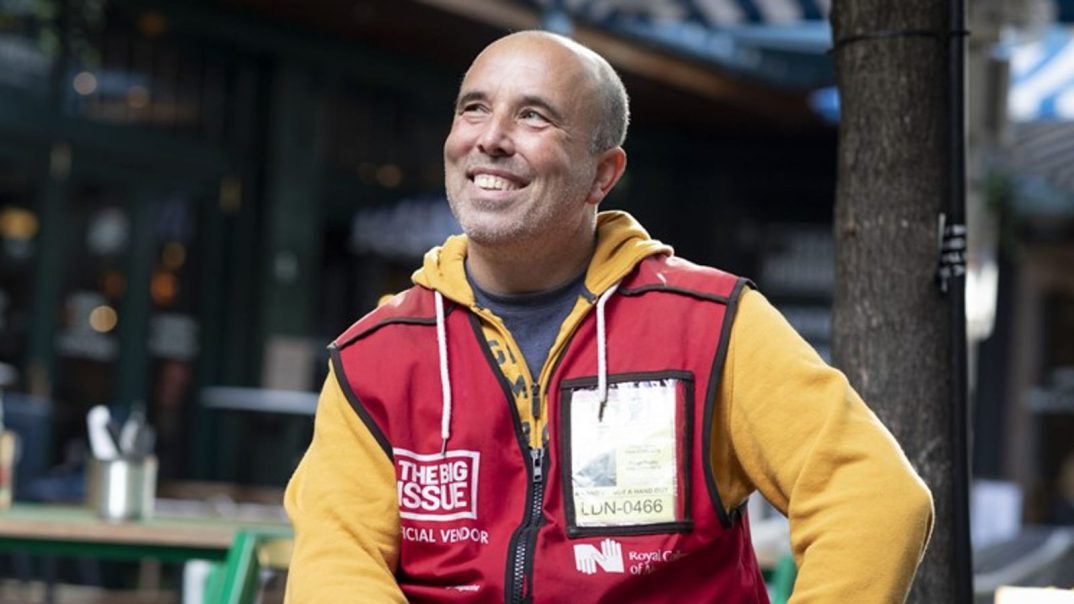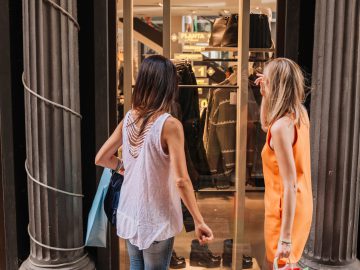By Bhvishya Patel, Money team
It was easy to find him – the red jacket stuck out in the slow-moving crowd.
I’d come to meet Andre Rostant in Soho on a Friday afternoon armed with a list of questions: those that occur to me and probably most of us when we pass a Big Issue seller on the street.
They ranged from the personal to the practical – how does it all work? How do vendors make money?
Most of them, it turned out, Andre was prepared to answer – some he wasn’t.
What are the criteria?
Andre, who is 60, has been a Big Issue vendor for more than a decade.
Founded in 1991 and now the world’s most widely circulated street newspaper, the magazine offers homeless people, those at risk of homelessness or those experiencing poverty a chance to earn an income.
There is no application form but sellers must be over the age of 18.
Once their age has been verified, a vendor is allocated a pitch and can start selling the magazine immediately that day – they get five free copies to sell initially.
How much do sellers earn?
The Big Issue operates as a business and vendors buy their magazines for £2 and sell them for £4, making £2 a copy.
Sellers “are immediately earning and putting [money] into their pocket”, says Catherine Parsons, managing director of the Big Issue Changing Lives Community Interest Company.
“It’s their stock and their investment so every sale counts for those vendors,” she adds. “While £2 doesn’t sound a lot, it is a lot to that individual.”
Andre, who lives in temporary accommodation with his teenage children, says his job is a “flexible way of making money” when he needs – though not a long-term solution.
He says it works as “supplemental income or emergency income”, adding: “It would be perhaps ambitious to use it as your sole income. It’s a difficult thing to make a full income out of.”
Alongside selling the magazine, Andre does other work where he can – until three weeks before I met him he was also working three days a week doing secretarial work at a law firm.
When you’re homeless, Andre says, “a lot of your spending is on emergency stuff because things break and run out and if you are waiting until the end of the month you just don’t have the money – but with this you do.
“With this, you can fill in the gaps.”
What is a typical day like?
Andre had been at his pitch for about three hours when I met him and was rounding off for the day.
There’s no set times for sellers to be on the street – but a typical shift might be five or six hours. Many other vendors do part-time or casual work alongside, like Andre.
The key, he says, is being consistent about the time spent on your pitch, comparing selling to fishing: “Some days you can stand here and as pretty as you look, you can just stand here for a couple of hours and people walk past smiling and someone might give you a pound.
“On another day it’s as though the fish are jumping in.
“You could sell no magazines one day and 20 the next.”
‘It’s a blunderbuss technique but it works’
So what’s the best way of getting someone to stop and buy a copy?
Andre’s method is simple: “I’m not shy of people – my technique of selling is I will stand in the middle of the pavement as an obstruction and by way of attrition you will get sales.
“I make a sound, I’m standing in the middle of the pavement – it’s a very blunderbuss technique but it works.”
Most interactions are positive, he says: “The experience of people is overwhelmingly good. People are overwhelmingly sympathetic and good.
“But I’ve had in the past young drunk men dragging my magazines and shouting out things. There is a presumption that this is something we are begging for – it’s not.
“In the same way WH Smith is there on the corner selling magazines, I’m here on this corner selling magazines in the same way. I buy them and sell them.”
From destitution to published author
My last question was personal: how did Andre come to find himself outside a Foyles bookshop near Leicester Square selling the Big Issue?
He tells me he became homeless in 2012 – he was “destitute” and in “terrible debt”.
He had worked for the Financial Services Authority doing secretarial work before he lost his home.
He’s not comfortable sharing any more details, but he hints at the difficulties he has faced: “I think I would have imploded in some way if I had tried to just keep doing a regular five-day-a-week job with the pressure of the children and the pressure of the circumstances that led to our being homeless.
“I just couldn’t have done it.”
Andre’s experiences of poverty have also inspired him to write a book, The Muffin Man, which was published in June and explores the mind of a Big Issue vendor working in the underbelly of Soho.
It was published by Arkbound, a charity book publisher, but he was repeatedly rejected at first: “I sent my manuscript to a load of publishers and all of them wrote back and said ‘this is interesting but it’s not our cup of tea’.”
‘This job has saved lives’
Selling the Big Issue is about much more than the money for Andre – it’s life-saving.
“This is a way of meeting contingencies and finances but more importantly than that, perhaps, is the human contact,” he says.
“It’s interacting with people which you wouldn’t necessarily otherwise get.”
He says: “If you are homeless and single, who do you communicate with? Who do you meet? Who do you see during the day?
“This interaction brings you back into the real world. I can say for certain that this job has saved lives.
“There are people who might otherwise have taken their life but because of this and the interaction with other people, they don’t.”
He also says the Big Issue acts as a “a stepping stone back into regular society”.
Ms Parsons agrees: “It’s a really difficult job and not very well paid and we assume that people who want to sell are people affected by poverty.
“It’s that sense of belonging to a community and having regular people they can talk to and a sense of being seen and heard.
“It’s a really important structure in lots of people’s lives – it gives them a reason to get up and get out of bed in the morning.
“It’s also really important that those vendors are not just standing outside, sometimes in the rain, for six hours and people are not just walking by and not even making eye contact.
“The one person that stops and buys a magazine will keep them going for another hour getting wet in the rain.”
In the end, Andre says, Big Issue sellers have many of the same struggles as most people do.
“While I still need to find a fiver for milk and bread – this helps take the edge off,” he says.
“And it’s London – everybody has got multiple jobs and nobody has got any money. We’re all working like maniacs just to stand still.
“If I do this I can make sure my children have shoes on their feet and clothes on their back and food in their bellies.”
Anyone over 18 can start earning a legitimate income almost immediately by becoming a Big Issue vendor. You’ll receive full support, work fully flexibly and get five free copies to sell initially. Just email vendor.support@bigissue.com for more information.



